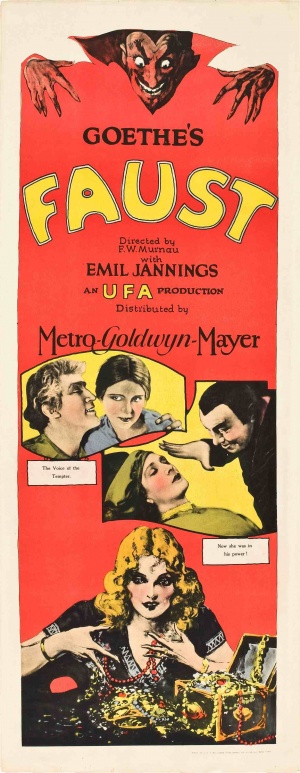 The incomparable F.W. Murnau adapts Goethe’s FAUST, and the results are memorable, as you might expect—a tad effects-heavy maybe, but still quite memorable. Murnau was perhaps Germany’s top director of the 1920s, yet had a preference for dark and horrific fare. His most famous film remains the legendary DRACULA rip-off NOSFERATU, certainly one of the most influential vampire pictures of all time. The 1926 FAUST (FAUST-EINE DEUTSCHE VOLKSSAGE) was a far more expensive and extravagant work, indeed the most expensive German film of its time, but fared less well with critics and audiences.
The incomparable F.W. Murnau adapts Goethe’s FAUST, and the results are memorable, as you might expect—a tad effects-heavy maybe, but still quite memorable. Murnau was perhaps Germany’s top director of the 1920s, yet had a preference for dark and horrific fare. His most famous film remains the legendary DRACULA rip-off NOSFERATU, certainly one of the most influential vampire pictures of all time. The 1926 FAUST (FAUST-EINE DEUTSCHE VOLKSSAGE) was a far more expensive and extravagant work, indeed the most expensive German film of its time, but fared less well with critics and audiences.
The film was adapted from Johann Wolfgang Goethe’s immortal 19th Century drama by Gerhart Hauptmann and Hans Kyser, who added much of their own to Goethe’s account. Yet the film, despite its qualities, remained quite obscure until 1995, when a restored version was finally made available.
In Germany of the middle ages, plague ravages the land. The stricken inhabitants of a small village call on the elderly scientist Faust to find a cure. But Faust is unable to follow through, and is eventually driven to a desperate act: he summons the Devil in the form of Mephisto, a slimy man who appears out of thin air and makes Faust sign a waver in his own blood. The waver states that Faust is giving his soul over to the powers of darkness for a single day, during which he’ll be granted the power to help his fellow villagers.
The villagers scorn Faust when he recoils before a cross, and so makes clear that he’s in league with the powers of darkness. Faust resummons Mephisto to request that the bargain be lifted, but Mephisto counters with a new proposition: he’ll make Faust young again. Faust can’t resist this, and is not only made into the strapping young man he once was, but taken on an exhilarating flight around the world. Faust enjoys the experience immensely, especially when Mephisto sets him down in Italy, where he becomes the lover of an Italian duchess. It’s all so much fun that Faust is moved to extend the scope of the bargain from a single day to eternity.
However, after years of mortal indulgence Faust decides he wants to return to the humble village where he lived previously. The Devil grants this wish, but keeps up his influence, complicating Faust’s relationship with the lovely Gretchen. A murder ensues, followed by a baby killing and a death sentence for the unfortunate Gretchen…but the forces of good have a final card to play against Faust and Gretchen’s adversaries.
If this film proves anything it’s that special effects have always been an integral component of the cinema. This FAUST is among the most effects heavy films of its time, with virtually the entire spectrum of 1920’s-era visual effects art on display. It’s significant that the core of the story—Faust’s relationship with Gretchen—doesn’t occur until over halfway through, and then feels somewhat halfhearted in light of the visual brilliance that came before (and I’m sure is largely responsible for the tepid reception the film initially received).
But taken purely as a visual spectacle, F.W. Murnau’s FAUST remains virtually unrivalled. Murneau’s command of the medium is absolute, with a perfectly calibrated symphony light and shadow that far outdoes the more famous NOSFERATU. Scenes like that of a giant Mephisto glowering down at Faust’s village or Faust’s spectacular flight over a stunningly detailed miniature Earth are exhilarating and unprecedented examples of pure cinema. This film proves that while horror often functions best in spare and confined bursts, a more expansive, extroverted approach can work just as well.
Vital Statistics
FAUST (FAUST-EINE DEUTSCHE VOLKSSAGE)
Universum Film
Director: F.W. Murnau
Producer: Erich Pommer
Screenplay: Gerhart Hauptmann, Hans Kyser
(Based on the play by Johann Wolfgang Goethe)
Cinematography: Carl Hoffmann
Editing: Elfi Bottrich
Cast: Gosta Ekman, Emil Jennings, Camilla Horn, Frida Richard, William Dieterle, Yvette Guilbert, Eric Barclay, Hanna Ralph, Werner Fuetterer
